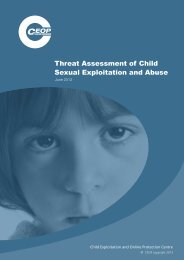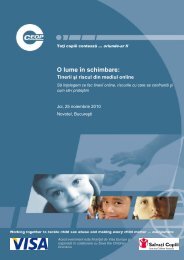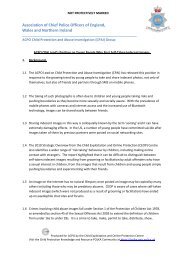Threat Assessment of Child Sexual Exploitation and Abuse - Ceop
Threat Assessment of Child Sexual Exploitation and Abuse - Ceop
Threat Assessment of Child Sexual Exploitation and Abuse - Ceop
You also want an ePaper? Increase the reach of your titles
YUMPU automatically turns print PDFs into web optimized ePapers that Google loves.
10<br />
<strong>Threat</strong> <strong>Assessment</strong> <strong>of</strong> <strong>Child</strong> <strong>Sexual</strong> <strong>Exploitation</strong> <strong>and</strong> <strong>Abuse</strong> 2012<br />
Section 3 Priority Themes<br />
1. The targeting <strong>of</strong> children online based on their heightened vulnerability<br />
There are a number <strong>of</strong> ways in which children are persuaded, manipulated, groomed or threatened into performing sexual<br />
activity over webcam or sending indecent images to an adult <strong>of</strong>fender in a way that constitutes non contact sexual abuse.<br />
In many cases this follows a similar pattern to <strong>of</strong>fline grooming where persuasion by the <strong>of</strong>fender for a child to expose<br />
themselves sexually <strong>of</strong>ten gives way to threats <strong>and</strong> intimidation.<br />
In the past year CEOP received reports indicating that children were being incited to perform sexual activity via webcam<br />
by means <strong>of</strong> targeted criminal coercion by <strong>of</strong>fenders. Offenders will use various methods to coerce a child into giving their<br />
username <strong>and</strong> password for a social networking site. Compromising the child’s social networking presence in this way is<br />
used by the <strong>of</strong>fender to get the child to perform sexual acts or send indecent images online. This then forms the basis for<br />
further threats <strong>and</strong> incitement to perform increasingly serious sexual acts.<br />
In such situations, children <strong>of</strong>ten fail to underst<strong>and</strong> the abuse they have suffered. Researchers <strong>and</strong> therapists believe that this<br />
is because <strong>of</strong> children’s heightened sense <strong>of</strong> shame, exposure <strong>and</strong> lack <strong>of</strong> control over the disclosure process. Operational<br />
experience over the last year supports this.<br />
In the online environment, evidence from a study <strong>of</strong> 25,000 children across the European Union in 2011 found that teenagers<br />
reported encountering more risks online than younger children, with 63% <strong>of</strong> 15 <strong>and</strong> 16 year olds reporting one or more forms<br />
<strong>of</strong> illegal or upsetting behaviour online. Significantly, the study also found no discernable difference between the likelihood <strong>of</strong><br />
girls <strong>and</strong> boys encountering such risks online.<br />
Whilst Ofcom’s <strong>Child</strong>ren’s <strong>and</strong> Parents’ Media Use <strong>and</strong> Attitudes report found that the number <strong>of</strong> 12–15 year olds<br />
communicating with people they don’t know in such environments fell by a quarter in 2011 to 24%, a wider report for<br />
EU Kids Online7 identified that almost half <strong>of</strong> 15 <strong>and</strong> 16 year olds across Europe had contact with new people online.<br />
Whilst online grooming for sexual purposes is not new, the use <strong>of</strong> sometimes subtle social engineering techniques to this<br />
end appears to be a relatively recent phenomenon. Without sufficient recognition <strong>and</strong> intervention from law enforcement<br />
there is every likelihood that this trend will grow. With the forecasted growth <strong>of</strong> internet use across the world, particularly<br />
in developing nations, it is also increasingly likely that UK children will also be targeted by <strong>of</strong>fenders based overseas.<br />
Key findings<br />
8 Offenders are targeting children through social networking sites.<br />
8 Offenders use social engineering techniques to gain control over the social networking accounts<br />
<strong>of</strong> young children.<br />
8 Offenders use threats to coerce children into performing harmful <strong>and</strong> degrading sexual activity online.<br />
2: Those who sexually <strong>of</strong>fend against children using the anonymity afforded by the hidden internet<br />
The hidden internet provides a perception <strong>of</strong> anonymity for those surfing or hosting websites. Websites facilitating money<br />
laundering, drug use, trafficking <strong>and</strong> other forms <strong>of</strong> criminality proliferate across such networks with a significant <strong>and</strong><br />
growing use by those with a sexual interest in children. Of course, not all users <strong>of</strong> the hidden internet access these<br />
networks for criminal purposes but the overwhelming majority <strong>of</strong> sites <strong>and</strong> forums available relate to unlawful activity<br />
<strong>of</strong> one form or another.<br />
Hidden internet sites are believed to be a source <strong>of</strong> new or ‘first generation’ indecent images <strong>of</strong> children. Many indecent<br />
images <strong>and</strong> videos are seen for the first time on such sites, suggesting many <strong>of</strong> the users are involved in the production<br />
7 Disadvantaged <strong>Child</strong>ren <strong>and</strong> Online Risk, Livingstone et al, 2011.











